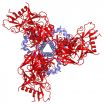(Press-News.org) Cut off by freeways and human development, mountain lions in southern California are facing a severe loss of genetic diversity, according to a new study led by the University of California, Davis in partnership with The Nature Conservancy.
The study, published today in the journal PLOS ONE, represents the largest genetic sampling of mountain lions, or pumas, in southern California. It raises concerns about the current status of mountain lions in the Santa Ana and Santa Monica mountains, as well as the longer-term outlook for mountain lions across southern California.
UC Davis School of Veterinary Medicine scientists collected and analyzed DNA samples from 354 mountain lions statewide, including 97 from southern California. Pumas in the Santa Ana Mountains displayed lower genetic diversity than those from nearly every other region in the state.
Santa Ana mountain lions show dramatic genetic isolation and have less in common with their neighbors in the Santa Monica Mountains than with those in the Sierra Nevada, underscoring the increasing seclusion of pumas in southern California.
The Santa Ana Mountain range, located south of Los Angeles and north of San Diego, is surrounded by urbanization and a growing population of about 20 million people. A small habitat linkage to the southeast connects pumas to the Peninsular Range, but it is bisected by Interstate 15 -- a busy 10-lane highway -- and associated human development. The study highlights the urgency to maintain and enhance the little connectivity remaining for coastal mountain lions, particularly across I-15.
The study also showed that the Santa Ana pumas recently went through a "population bottleneck," when the population's size sharply decreased to a fraction of its original size.
"The genetic samples give us a clear indication that there was a genetic bottleneck in the last 80 or so years," said lead author Holly Ernest, a professor with the Karen C. Drayer Wildlife Health Center and the Veterinary Genetic Laboratory at UC Davis at the time of the study. She is now a professor at the University of Wyoming, Laramie. "That tells us it's not just natural factors causing this loss of genetic diversity. It's us – people –impacting these environments."
Pumas in the Santa Monica Mountains are similarly threatened by low genetic diversity, inbreeding, and lions killing other lions, according to a study co-authored by Ernest published in September's issue of Current Biology. Just one lion was known to cross Highway 101 during the study period, and he significantly increased the genetic diversity of that population, the study found.
Winston Vickers, co-author of the PLOS ONE study and leader of the puma field study in southern California, said the studies help paint a conservation picture of the region and reinforce the idea that very little movement across the freeway is occurring.
"It's not just one isolated spot you can dismiss," said Vickers, an associate veterinarian with the UC Davis Wildlife Health Center. "It can happen anywhere. If we keep building without attention to these issues, we're going to keep creating more pockets of isolation where animals can no longer connect with each other."
Study co-author Scott Morrison, science director for The Nature Conservancy in California, said the conservation implications of the highway barrier are serious.
"This study really highlights the impact a road can have on wildlife," he said. "The land-use decisions made along Interstate 15 over the next few years may well be fateful for lions in the Santa Ana Mountains."
For a textbook example of why genetic diversity is important, look to the Florida panther. Loss of genetic diversity among the panthers had become so severe by the 1990s that panthers were having trouble reproducing. Several of those that did reproduce had babies with heart defects. Millions of dollars have since been spent on their slow recovery.
In addition to low genetic diversity, southern California pumas are threatened by habitat loss and fragmentation, and death from numerous causes including vehicles, depredation permits, poaching, disease, public safety kills, wildfire and poisoning. An elevated combination of these factors could be a tipping point for the population.
However, Ernest said it is not too late to protect the region's mountain lions.
"I think there could be hope for this population," Ernest said. "They're at a point where they can be monitored and protected. They don't have to end up like Florida panthers. With early interventions, we wouldn't have to spend millions and millions of dollars later."
Possible measures could include protecting migration corridors and some lands slated for development that could connect the Santa Anas to areas in the east, as well as strategically installing protective corridors for the lions to navigate busy highways.
INFORMATION:
Other authors in the study include Michael Buchalski and Walter Boyce from the UC Davis School of Veterinary Medicine.
The work received funding from the California State Parks, California Department of Fish and Wildlife, The Nature Conservancy, The McBeth Foundation, Anza-Borrego Foundation, Nature Reserve of Orange County, National Science Foundation, and private donors. The Nature Conservancy and California Department of Fish and Wildlife helped with sample and data collection.
Plant scientists are working to improve important food crops such as rice, maize, and beans to meet the food needs of a growing world population. However, boosting crop output will require improving more than what can be seen of these plants above the ground. Root systems are essential to gathering water and nutrients, but understanding what's happening in these unseen parts of the plants has until now depended mostly on lab studies and subjective field measurements.
To address that need, researchers from the Georgia Institute of Technology and Penn State University have ...
Lebanon, NH, 10/8/14 —To reduce false positives when identifying genetic variations associated with human disease through genome-wide association studies (GWAS), Dartmouth researchers have identified nine traits that are not dependent on P values to predict single nucleotide polymorphisms (SNP) reproducibility as reported in Human Genetics on October 2, 2014.
Reproducibility rates of SNPs based solely on P values is low. Dartmouth authors' analysis of GWAS studies published in Nature Genetics showed a 1-5 percent replication rate.
"It is important to improve our ...
A new study from UCLA found that a drug being evaluated to treat an entirely different disorder helped slow the progression of Parkinson's disease in mice.
The study, published in the October edition of the journal Neurotherapeutics, found that the drug, AT2101, which has also been studied for Gaucher disease, improved motor function, stopped inflammation in the brain and reduced levels of alpha-synuclein, a protein critically involved in Parkinson's.
Although the exact cause of Parkinson's is unknown, evidence points to an accumulation of alpha-synuclein, which has ...
Astronomers working with NASA's Nuclear Spectroscopic Telescope Array (NuSTAR), led by Caltech's Fiona Harrison, have found a pulsating dead star beaming with the energy of about 10 million suns. The object, previously thought to be a black hole because it is so powerful, is in fact a pulsar—the incredibly dense rotating remains of a star.
"This compact little stellar remnant is a real powerhouse. We've never seen anything quite like it," says Harrison, NuSTAR's principal investigator and the Benjamin M. Rosen Professor of Physics at Caltech. "We all thought an ...
ATLANTA – October 08, 2014 – A study from American Cancer Society researchers finds the increased risk of premature death associated with a higher body mass index (BMI) is similar for African Americans and whites, in contrast to previous, smaller studies that indicated the association may be weaker for African Americans. The study, published in the open-access, online publication PLOS ONE, finds that among never smokers without prevalent disease, overweight and obesity are strongly associated with subsequent risk of mortality in every race. The authors say ...
New Haven, Conn. - HIV is adept at eluding immune system responses because the protein it uses to infect cells is constantly changing.
Now a team of researchers including scientists from Yale have stripped the cloak from this master of disguise, providing a high resolution image of this surface spike protein and monitoring how it constantly changes its shape, information that suggests new ways to attack the virus through drugs and vaccines.
In two papers published simultaneously online Oct. 8 in the journals Science and Nature. team of researchers led by scientists ...
Highly-detailed radio-telescope images have pinpointed the locations where a stellar explosion called a nova emitted gamma rays, the most energetic form of electromagnetic waves. The discovery revealed a probable mechanism for the gamma-ray emissions, which mystified astronomers when first observed in 2012.
"We not only found where the gamma rays came from, but also got a look at a previously-unseen scenario that may be common in other nova explosions," said Laura Chomiuk, of Michigan State University.
A nova occurs when a dense white dwarf star pulls material onto ...
New research has illuminated the movement and complete structure of the spikes on HIV that the virus uses to bind to the cells it infects. This research, led by scientists at the National Institutes of Health, Weill Cornell Medical College and Yale University School of Medicine, could help advance efforts to develop HIV vaccines and treatments.
Three sets of a pair of molecules called gp120 and gp41 constitute each HIV spike, which adopts different configurations before and after the virus fuses with a cell. The atomic-level structures of pre-fusion gp120 and post-fusion ...
NEW YORK — (October 8, 2014) -- Researchers at Weill Cornell Medical College have developed technologies that allow investigators, for the first time, to watch what they call the "dance" of HIV proteins on the virus' surface, which may contribute to how it infects human immune cells. Their discovery is described in the Oct. 8 issue of Science, and is also a part of a study published the same day in Nature.
The new technology platform opens new possibilities for devising an approach to prevent HIV infection, says Dr. Scott Blanchard, an associate professor of physiology ...
Astronomers have discovered a black hole that is consuming gas from a nearby star 10 times faster than previously thought possible. The black hole—known as P13—lies on the outskirts of the galaxy NGC7793 about 12 million light years from Earth and is ingesting a weight equivalent to 100 billion billion hot dogs every minute.
The discovery was published today in the journal Nature.
International Centre for Radio Astronomy Research astronomer Dr Roberto Soria, who is based at ICRAR's Curtin University node, said that as gas falls towards a black hole it gets ...



